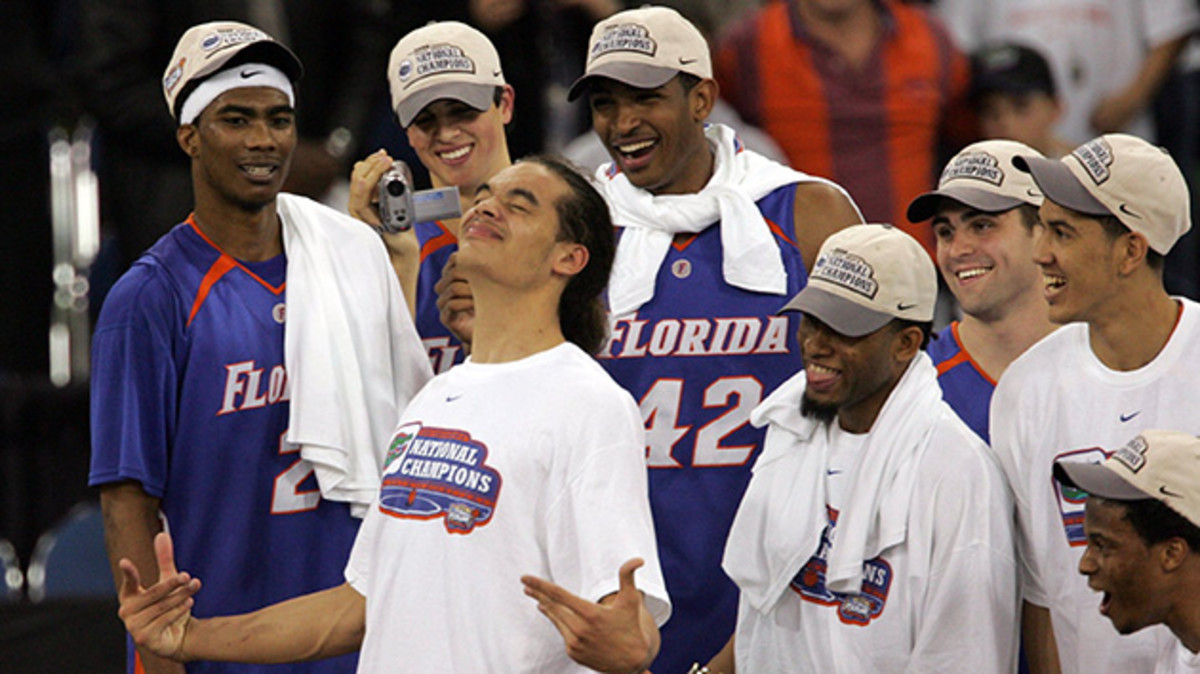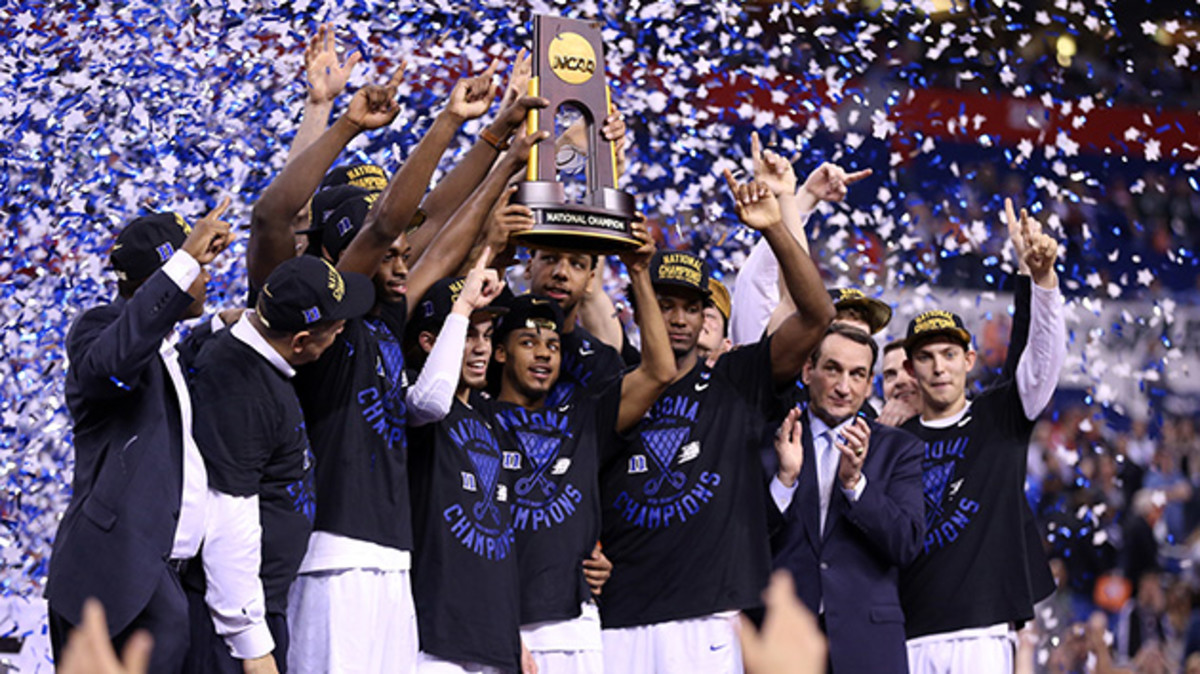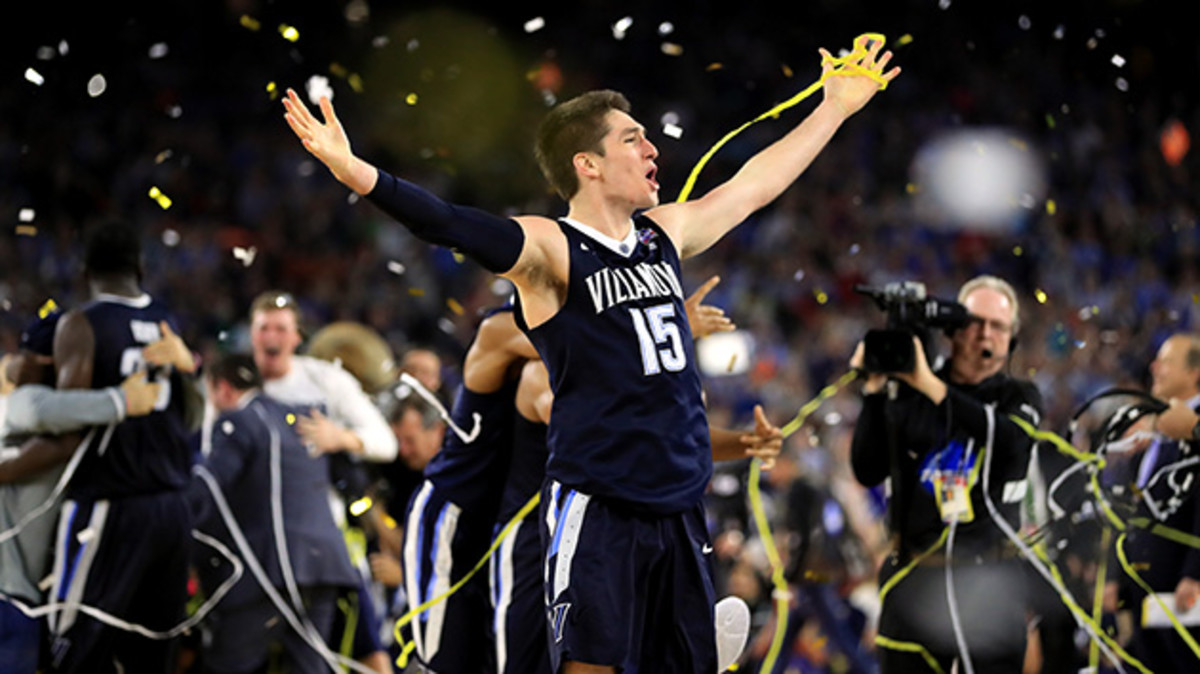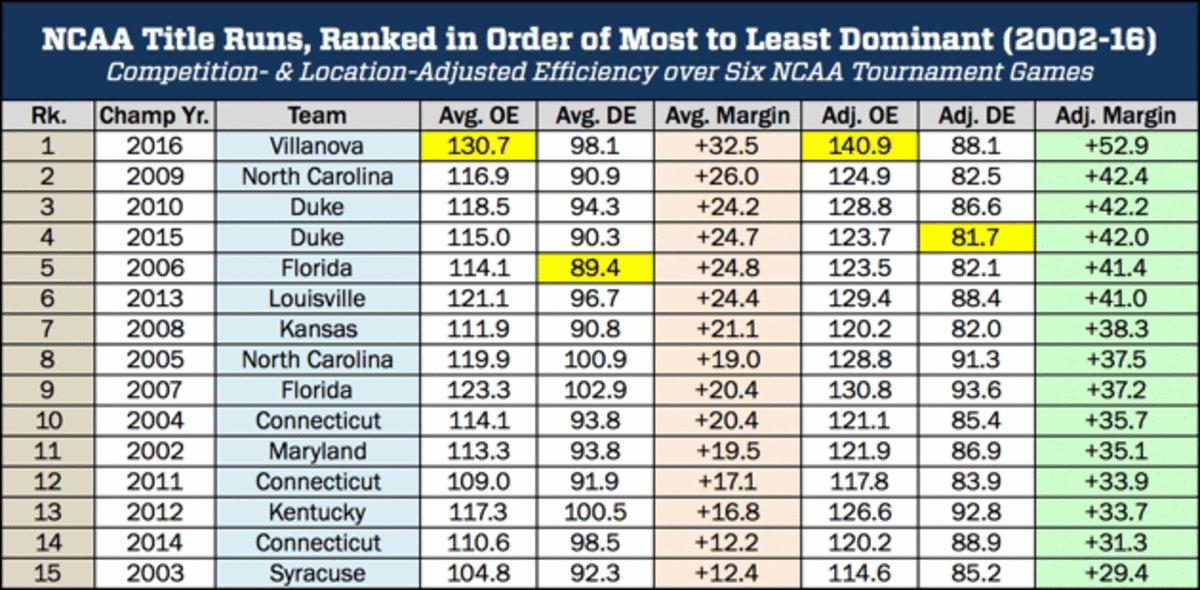The five most dominant title runs of the analytics era

Get all of Luke Winn’s columns as soon as they’re published. Download the new Sports Illustrated app (iOS or Android) and personalize your experience by following your favorite teams and SI writers. Villanova fans, you can purchase a commemorative championship issue of Sports Illustratedhere.
Villanova’s Jay Wright pulled off a rare double feat in the 2016 NCAA tournament: He did the best coaching job of anyone in the bracket, all the while maintaining the best perspective on college basketball’s use of a six-round, single-elimination tournament to crown its national champion.
“This tournament isn’t about finding out the best team,” Wright said after his team had just crushed the collective soul of Oklahoma, routing the Sooners 95–51 in the Final Four. “It’s about finding out who’s playing the hottest at this time.”
I asked Wright that night when he first thought the 2015–16 Wildcats were a title-caliber team, and he said, “I don’t know if I ever thought we were a title-caliber team. I kept seeing us get better. The [previous] two years, I thought we were a title-caliber team because we were good defensively throughout the year. This team wasn’t. This team was ... continuing to get better defensively. So we were saying, ‘Hey, we can make a run.’ I don’t think any of us said, ‘Hey, we’re getting to the final.’ It just shows you, when a team is hot in this tournament ...”
Philadelphia Threedom: How Villanova became the national champion
Villanova was indisputably hot in this tournament, and it stayed hot through the final tenths of a second in the final game—in which Kris Jenkins hit a legendary three but the Wildcats also shot 58.3% from the field, and their defense held North Carolina’s scoring attack in relative check. Would anyone call Villanova the best team of the entire ‘15–16 season? There’s room for an argument, but Kansas probably deserves that designation after winning 17 straight games from Jan. 30-March 24, and winning the regular-season and tourney titles in the most difficult conference in the country. Would anyone call Villanova the most talented national champ in recent memory? No: That’s a debate between 2005 North Carolina, 2007 Florida, 2012 Kentucky or 2015 Duke. But one thing I did suspect while covering ‘Nova was that it might have been putting on the most dominant NCAA tournament performance of any modern-era champ.
That was not a question that could be answered on the night of the Wildcats’ 77–74 win over North Carolina—that was a night for living in the moment, for trying to write pieces that captured perhaps the greatest title-game finish of all time. It was not a night for being coldly analytical. A week later, though, it’s a question that can be fairly attacked with data, without risk of minimizing the moment.
Thanks to kenpom.com, single-game efficiency data is available for the past 15 NCAA tournaments, from 2002 to ‘16. I collected the data for every champion’s six-game, NCAA tournament run, and then adjusted each game’s offensive and defensive efficiency based on the quality of opponent, because the difficulty of all title runs is not equal. I then ranked the past 15 champs by their average adjusted efficiency margin in the NCAA tournament, to try to identify which team had the most dominant, six-game title run of the analytics era.
What follows is a countdown of the five most dominant champs, along with their average adjusted efficiency margin—a figure that essentially represents the quality of their NCAA tournament performance, converted to 100 possessions against a Division I average opponent in their respective seasons. Surprisingly, most of the champs on the shortlist for Most Talented don’t appear on the shortlist for Most Dominant:

5. 2006 Florida (+41.4 points per 100 possessions)
This was the first of the Gators’ back-to-back championships, and it was not preordained: They began the season unranked in the Associated Press poll, were 16th in the final version prior to the NCAA tournament, and were a No. 3 seed in the bracket. The core of this team’s identity was the Joakim Noah-Al Horford-Corey Brewer frontcourt—particularly the energy and exuberance of the then-21-year-old Noah, who said on the court after they won it all, “This is better than sex! And trust me, I’m doing it right.” But they were also defending passionately, holding every opponent in the tourney to under 1.00 points per possession—and UCLA to just 0.88 PPP in the title game. This Florida team was more dominant in the tourney than the one that came back to win a second title in ‘07, and should be regarded as one of the great tourney defenses ever.
• MORE: Ranking the five best title games of the modern era
4. 2015 Duke (+42.0)
This team is historically significant as coach Mike Krzyzewski’s successful embrace of the one-and-done era, but should it remembered equally as much for its late-season transformation? These Blue Devils had the worst adjusted defensive efficiency ranking, entering the tournament, of any eventual champ—57th in the nation. Their defense was in such a crisis in January, with guards Quinn Cook and Tyus Jones getting destroyed off the dribble in isolation, and center Jahlil Okafor struggling to guard ball-screens or rim-protect, that pundits were writing long and justified pieces about its flaws, and Coach K had to mix in some 2-3 zone to keep the team afloat.
Two months later, Duke had the most dominant defensive NCAA tournament of any champ in the analytics era, holding five of its six opponents (including Utah, Gonzaga and Michigan State) to under 0.90 PPP, and Wisconsin’s otherwise-otherworldly offense to a pedestrian output. The Blue Devils did it by mostly using a small lineup with stout defenders Matt Jones and Justise Winslow at the 3-4 spots, and playing drastically improved man-to-man. Coach K likened the season to a course in which his inexperienced students were evaluated purely by the end-total of their learning. “If I was a teacher, I wouldn’t do cumulative grades,” he said prior to the ‘15 title game. “If you got it for a semester, a test in October, and a test in November, this is a percentage of this grade, I would see if my student learned by the end of my class, by the end of the semester. In other words, when do you get it? For us, our guys get it right now.”

3. 2010 Duke (+42.2)
The Blue Devils had the most efficient offense in the nation over the course of the ‘09–10 season, powered by the 1-2-3 combo of Jon Scheyer, Nolan Smith and Kyle Singler, and the offensive rebounding excellence of center Brian Zoubek. In the Final Four, they scored more PPP against West Virginia (1.43) than any team had all season, and by scoring 1.01 PPP in the title game, they became one of just two teams to crack 1.00 PPP against Butler after Christmas of that season. That Bulldogs squad was coach Brad Stevens’s best-ever college D, and ranked second nationally in defense efficiency. Duke obviously did not dominate the final—it came with a few inches of losing on Gordon Hayward’s halfcourt heave—but it had five high-quality games prior to that escape.
• MORE: Duke is No. 1 in Way Too Early Top 25 for 2016–17
2. 2009 North Carolina (+42.4)
Like Duke in ‘09–10, the Tar Heels had the country’s most efficient offense in ‘08–09—and even more future NBA players, in the quartet of Tyler Hansbrough, Wayne Ellington, Danny Green, Ty Lawson and Ed Davis. Their tourney success, though, had more to do with their defense than their scoring. In the South Regional in Memphis, they shut down two of the nation’s elite offenses in Gonzaga (which had Austin Daye and Jeremy Pargo) and Oklahoma (led by Blake Griffin and Willie Warren). That was Griffin’s final college game, and it was the Sooners’ second-worse offensive performance of the season. UNC then suffocated Villanova and Michigan State in the Final Four, and finished the tourney with an average victory margin of 20.2 points.

1. 2016 Villanova (+52.9)
My hunch was correct: What we witnessed out of Villanova in March and April was the most dominant run by any title team in the past 15 seasons. And while that destruction of Oklahoma does exaggerate the dominance a bit, the Wildcats did wild things for the entirety of the tournament. Their defense, which slowed down previously unstoppable Kansas, Oklahoma and North Carolina, was their fuel for some unfathomably good offense. Their adjusted offensive efficiency rating of 140.9 makes for the greatest scoring run by any analytics-era champ, and they had plenty of hard-to-believe box-score stats, too—such as point guard Ryan Arcidiacono shooting 71.4% on twos and 61.5% on threes in the tourney, or the team shooting 62.8% on twos and 50.0% on threes.
Villanova had two games (against Miami and Oklahoma) in which it scored better than 1.50 PPP, and its efficiency against the Sooners was so good that Wright felt like he had to apologize. “That was just one of those games that could happen to anybody,” he said that night in Houston. “I feel bad for Oklahoma that it happened to them in the Final Four.” The ever-frank Lon Kruger stated that his team got “whipped in every way.” And after the final, North Carolina coach Roy Williams’s description of his experience watching Jenkins’ buzzer-beater during its net-ward arc—“It was helpless; it was not a good feeling”—was like the experience of all Villanova NCAA tournament opponents, in a nutshell. There were occasional times when things they wanted to happen, happened. But mostly, they were helpless against an unstoppable wave.
SI’s complete ranking of 2002-16 champs, from most to least dominant NCAA tournament runs, is as follows:

